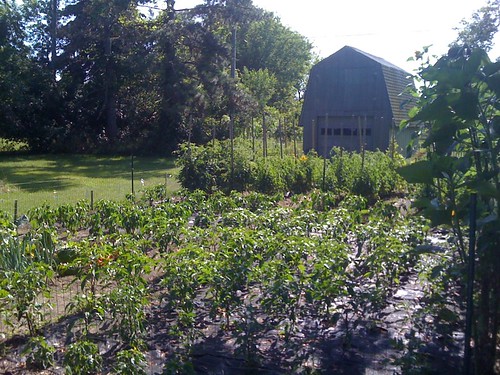Mrs. E and I have been organic gardening together for about seven years and recently moved to a new home with an acre of land about three years ago. We now have a very nice garden, 100% organic, lush and productive. We preserve an amazing amount of food from it and, every week of the year, we eat at least two meals, often more, that are mainly from our garden.
Below are some of the tricks and techniques we’ve learned over the years to combat pests organically. Perhaps you’ll find something useful in them.
We have about 1300 square feet of gardening space. Here’s a partial list of what we harvest and/or preserve (clicking the links will take you to some remarkable photos taken by my wife):
- 80+ garlics, both softneck and hardneck
- 65+ quarts of canned heirloom tomatoes
- Dozens of grilled & frozen eggplants
- 300+ stuffed, breaded, par-baked and frozen jalapeno chilies
- Six large Ziploc bags of bell peppers, Anaheim chilies, Serrano chilies and jalapeno chilies
- Several bags of roasted-then-frozen Poblano chilies
- A half-dozen varieties of dried hot chilies including smoked red jalapenos (aka, “chipotles“)
- Several large bags of breaded, par-baked and frozen eggplant medallions
- Dozens of stuffed and frozen bell peppers (Mexican and Italian stuffings)
- Grilled and frozen Swiss Chard wraps
- 120+ onions
- Kale and Brussels sprouts
- A wide assortment of herbs
- Blanched and frozen snap peas, shell peas and asparagus
- Sauteed and frozen zucchini and kohlrabi
This list doesn’t include the many, many maters we eat throughout the season, lettuces, radishes, mizuna greens, carrots, basil and cilantro, all grown pesticide, herbicide, insecticide and synthetic fertilizer-free.
The soil where we live is very sandy so we have been amending it since we moved in with both homemade and purchased compost. The first recommendation I have for any organic gardener is to have very, very, very good soil! Why? Because happy, healthy plants are far more resistant to bugs, fungi and molds and recover much better if there is an incursion.
Starting soon, we will bring in horse manure (free from a local ranch) and mix it 1:1 with grass clippings and leaves). We put them in furrows about 10 feet long and 4 feet wide. These furrows are rolled once or twice a week and watered if it gets too dry. The temperature inside them will reach as much as 120°F which kills weed seeds, mold/fungi, and eggs/larvae. This will get tilled into the garden in the spring.
One thing I have learned from my bi-monthly issue of Mother Earth News is that you can actually over-till your garden. There are microscopic structures that live in the soil that are disrupted with too-frequent tilling. One good tilling in the spring is all I do. If you are going to till in the fall, make it a shallow, light till, according to my Mother and your soil will be happier.
We also have an active compost bin for our kitchen waste which produces something akin to black gold for gardening. A scoop of this magical dirt into the hole with every seedling ensures healthy plants with robust root structures.
We plant our own seedlings under lights starting in February which allows us to control the source of our plants so we don’t bring any cooties into our garden. We use an organic soil mixture purchased in 2.5 cubic foot bags and we are able to plant immediately after the last-frost date with very well-established plants, giving them a head start before the bugs and other pests can get ahold of them.
Removing plants in the fall is very important. This keeps flying critters from laying their eggs on them in the fall which fall to the ground when they hatch and over-winter in the soil as grubs/larvae. We didn’t do this last fall (I blame a guy named Barack Obama and his damn Campaign for Change!) and we had a BIG problem this spring with cutworms. Cutworms snip off the stems of perfectly healthy plants just above or below the soil. I actually had a jalapeno in my garden this year that was half-dragged down into the soil, its leaves sticking up like a Panicky Guy being sucked into quicksand! Plastic or cardboard tubes placed around the base of the seedling and pushed 1-2 inches down into the soil will reduce cutworm damage by up to 80%.
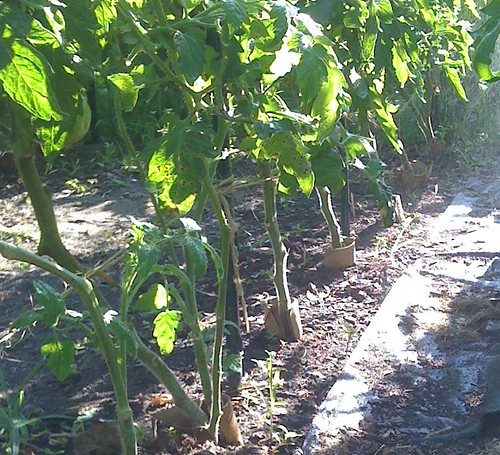
Cutworm tubes (click for a bigger photo)
If you do lose a plant to cutworms, dig around into the soil where the plant was. We lost about 10 plants this year (sob) and in all but one instance were able to find and dispatch the evil-doer before replanting.
For Japanese beetles we have found benefit in planting marigolds around the perimeter of the garden. The Japanese beetles seem to love them and they also repel other garden pests. About once a day I go out and brush the beetles off the marigolds into a dish of soapy water. Their trick is to drop down before flying off so hold the dish of soapy water under them as you brush them down and they will drop right in. Hah!
For flea beetles (deadly on eggplant seedlings) and cucumber beetles (deadly on zucchinis, cukes, and many other plants), nothing works so well as homemade yellow sticky traps. I have two of these next to a double row of eggplants and three more by our six zucchini & cucumber plants and have almost no problem with these insects. The traps are disgustingly effective and a month after installing them, they are literally covered with dead bugs. To make them, buy a pack of bright yellow plastic disposable plates. Staple them to posts 3-4 feet tall and then smear them with Tanglefoot (wear disposable gloves – trust me, you need to!) These are so effective that this year I had trapped a cucumber beetle on one side of the plate before I had even finished coating the other side with Tanglefoot!
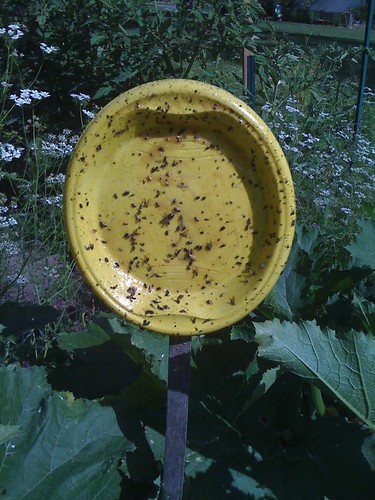
Yellow Sticky Traps (click for bigger photo)
Last year we discovered the value of having sunflowers planted along the north side of our garden. We had struggled with an infestation of tomato hornworms that threatened to devastate our tomatoes. We were hand-picking them off the plants but they are very hard to find. One day my wife noticed a male cardinal eating sunflower seeds from our ten-foot tall plants fly down into our tomatoes. He came out with a fat, juicy hornworm and gobbled it down YUM! Attracting birds to your garden is a Good Thing and they’ll take care of a surprising amount of insects. The bluebirds raising babies in our newly-installed bluebird box even got in on the act!
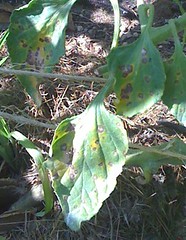 We have had a big problem with early tomato blight over the years, particularly on our favorite heirloom variety, Striped Roman. Early blight is like cancer on tomatoes, killing the plants branch by branch from the ground up. We combat this in several ways. First, we lay down soaker hose underground where the plants grow. That allows us to water without getting the leaves wet. We also mulch with grass clippings to help prevent soil splashing up and contaminating the plants with this soil-born fungus. Spread grass clippings about 3 inches deep and six inches around the base of the plants. Avoid touching the stems with them since grass clippings get very hot when they decompose. Finally, we spray a slurry of copper sulfate onto the plants early in the season before the fungus gets established and reapply after it rains. Staying on top of fungus infections is key. Once they get established, they are very hard to control.
We have had a big problem with early tomato blight over the years, particularly on our favorite heirloom variety, Striped Roman. Early blight is like cancer on tomatoes, killing the plants branch by branch from the ground up. We combat this in several ways. First, we lay down soaker hose underground where the plants grow. That allows us to water without getting the leaves wet. We also mulch with grass clippings to help prevent soil splashing up and contaminating the plants with this soil-born fungus. Spread grass clippings about 3 inches deep and six inches around the base of the plants. Avoid touching the stems with them since grass clippings get very hot when they decompose. Finally, we spray a slurry of copper sulfate onto the plants early in the season before the fungus gets established and reapply after it rains. Staying on top of fungus infections is key. Once they get established, they are very hard to control.
Using all of these techniques, most of which are very easy to do, has resulted in a garden that is more productive than many of those of my coworkers, most of whom use herbicides and insecticides. Just the two of us are able to have an amazing harvest every year without putting in an inordinate amount of effort.
Here’s a before and after picture of our garden. In the first picture, you can see where I have laid down the compost in rows for the peppers which are very large just two months later in the second picture. You can see the tomatoes in the background which are pushing five feet tall in just two months.
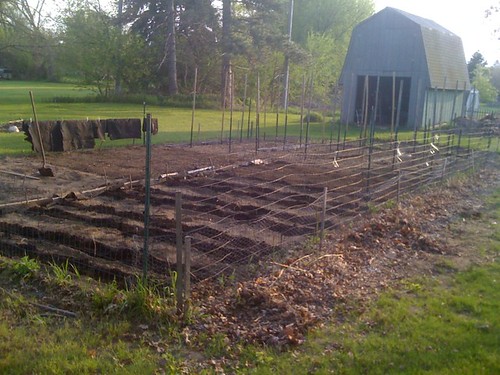
May 9th garden (click for a bigger photo)
In addition, we’ve connected ourselves to the soil and the earth in a way we wouldn’t have otherwise. We have learned to understand the chemistry, biology and microbiology of our garden ecosystem and use that knowledge to control pests in a way that benefits our environment as well as our garden. Using an integrated organic pest control approach, much like what is used at the commercial scale, we are able to avoid being wiped out by bugs and other pests and have an amazing assortment of fresh, nutritious produce without any chemical residues and without harming the ecosystem around we live in.
Hopefully you have found something useful here. I heartily recommend gardening, particularly using organic methods. C’mon in! The soil’s fine!
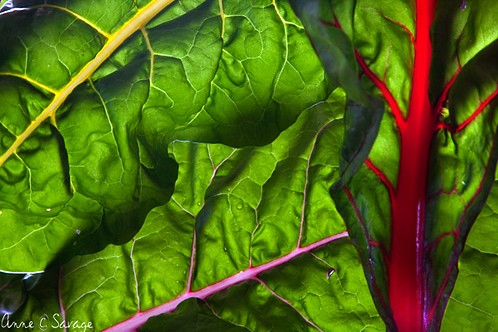
Photo credits (except the crappy garden shots which are from my iPhone): Anne Savage/Revolutionary Views. If you like the vegetable pictures, be sure to check out her website, blog, and Flickr page for more photographic awesomeness.
I’m just sayin’…


